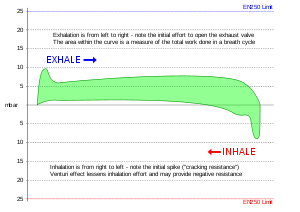Work of breathing
Work of breathing (WOB) is the energy expended to inhale and exhale a breathing gas. It is usually expressed as work per unit volume, for example, joules/litre, or as a work rate (power), such as joules/min or equivalent units, as it is not particularly useful without a reference to volume or time. It can be calculated in terms of the pulmonary pressure multiplied by the change in pulmonary volume, or in terms of the oxygen consumption attributable to breathing.[1][2] In a normal resting state the work of breathing constitutes about 5% of the total body oxygen consumption. It can increase considerably due to illness[3] or constraints on gas flow imposed by breathing apparatus, ambient pressure, or breathing gas composition.
Mechanism of breathing
The normal relaxed state of the lung and chest is partially empty. Further exhalation requires muscular work. Inhalation is an active process requiring work.[4] Some of this work is to overcome frictional resistance to flow, and part is used to deform elastic tissues, and is stored as potential energy, which is recovered during the passive process of exhalation, Tidal breathing does not require active muscle contraction during exhalation. The required energy is provided by the stored elastic energy.
When there is increased gas flow resistance, the optimal respiratory rate decreases.
Work against elastic recoil
This work (generally during the inhalation phase) is stored as potential energy which is recovered during exhalation.
Work against non-elastic resistance
A pressure difference is required to overcome the frictional resistance to gas flow due to viscosity, and to provide non-elastic components of movement of the airway tissues to accommodate pulmonary volume change.
Mechanics
Work is defined as a force applied over a distance. The SI unit of work is the Joule, equivalent to a force of 1 Newton exerted along a distance of 1 metre. In gas flow across a constant section this equates to a volume flowing against a pressure:[note 1]
Work = Pressure x Volume
and Power = Work / time
with SI units for Power: Watts = Joules per second
Work of breathing should more accurately be called power of breathing unless referring to the work associated with a specific number of breaths, or a given interval of time.
Signs of Increased Work of Breathing
Because measuring the work of breathing requires complex instrumentation, measuring it in patients with acute serious illness is difficult and risky. Instead, physicians determine if the work of breathing is increased by gestalt or by examining the patient looking for signs of increased breathing effort. These signs include nasal flaring, the contraction of sternomastoid, and thoraco-abdominal paradox.[5]
Underwater breathing apparatus

In the diving industry the performance of breathing apparatus is often referred to as work of breathing. In this context it generally means the work of an average single breath taken through the specified apparatus for given conditions of ambient pressure, underwater environment, flow rate during the breathing cycle, and gas mixture - underwater divers may breathe oxygen-rich Breathing gas to reduce the risk of decompression sickness, or gases containing helium to reduce narcotic effects. Standards for these conditions exist and to make useful comparisons between breathing apparatus they must be tested to the same standard.
Standards for testing underwater breathing apparatus
- EN 250:2014. Respiratory equipment – Open-circuit self-contained compressed air diving apparatus – Requirements, testing, marking.[6]
- EN 14143:2013. Respiratory equipment. Self-contained re-breathing diving apparatus[6]
- EN 15333 –1: 2008 COR 2009 – Respiratory Equipment – Open-Circuit Umbilical Supplied Compressed Gas Diving Apparatus – Part 1: Demand Apparatus.[6]
- BS 8547:2016 defines requirements for demand regulators to be used at depths exceeding 50m.[7]
Variations in work of breathing
Factors which influence the work of breathing of an underwater breathing apparatus include density and viscosity of the gas, flow rates, cracking pressure (the pressure differential required to open the demand valve), and back pressure over exhaust valves.
Measurement of underwater breathing apparatus performance
The ANSTI machine is used for automated testing of underwater breathing apparatus.[8]
Notes
- ↑ Force = Pressure x Area, and Distance = Volume / Area. When both refer to the same area, Force x Distance = (Pressure x Area) x (Volume/Area) = Pressure x Volume
References
- ↑ Medical Dictionary for the Health Professions and Nursing. S.v. "work of breathing." Retrieved September 8, 2015 from http://medical-dictionary.thefreedictionary.com/work+of+breathing
- ↑ Medical Dictionary. S.v. "work of breathing." Retrieved September 8, 2015 from http://medical-dictionary.thefreedictionary.com/work+of+breathing
- ↑ Mosby's Medical Dictionary, 8th edition. S.v. "work of breathing." Retrieved September 8, 2015 from http://medical-dictionary.thefreedictionary.com/work+of+breathing
- ↑ Aliverti, Andrea; Pedotti, Antonio (2014-06-19). Mechanics of Breathing: New Insights from New Technologies. Springer. p. 3. ISBN 9788847056473.
- ↑ Tulaimat, A; Patel, A; Wisniewski, M; Gueret, R (August 2016). "The validity and reliability of the clinical assessment of increased work of breathing in acutely ill patients.". Journal of critical care. 34: 111–5. PMID 27288621.
- 1 2 3 Staff (August 2014). "Diving Breathing Apparatus" (PDF). Diving Standards. Dublin: Health and Safety Authority. Retrieved 18 November 2016.
- ↑ Committee PH/4/7 (31 March 2016). BS 8547:2016 - Respiratory equipment. Breathing gas demand regulator used for diving to depths greater than 50 metres. Requirements and test methods. London: British Standards Institute. ISBN 978 0 580 89213 4.
- ↑ staff. "Life Support Equipment Test Facility" (PDF). Retrieved 18 November 2016.
